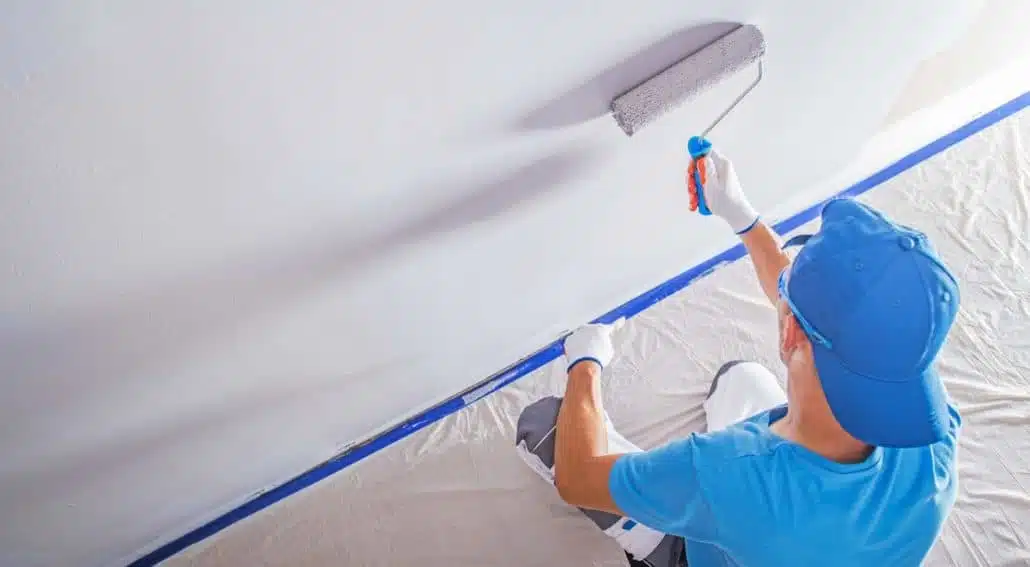It’s time for your kitchen walls to get a new look, but you want to make sure the finish will last and be durable.
So maybe you should just use exterior paint in the kitchen because it’s more durable, right? Can you use exterior paint on the interior?
Interior and exterior paints are different and are designed for specific uses, and it’s important to choose the right one for your particular job.
We’ll give you some guidance by comparing exterior and interior paints and explaining why you should reserve exterior paints for the outdoors.
Table of Contents
- Exterior Paint vs. Interior Paint — What Is the Difference?
- Expanding on Exterior Paint: Typical Characteristics
- Can You Use Exterior Paint Inside?
- 3 Reasons It’s Best Not to Use Exterior Paint Indoors
- What Happens When You Use Exterior Paint Inside?
- Durable Alternatives to Using Exterior Paint Inside
- Two Brothers Painting — Professional Interior and Exterior Painting Contractors in the Portland Metro Area for Over 20 Years
Exterior Paint vs. Interior Paint — What Is the Difference?
The names of the paint types themselves clue us into the most obvious difference — one is used outside while the other is used inside. But the differences don’t stop there.
To know whether you should choose interior or exterior paint for the particular parts of your home, pay careful attention to the following:
- Intention – Indoor paints are intended to be used indoors, where washing and scrubbing of walls are done often. Exterior paint, on the other hand, is intended to minimize damage from the outdoor elements where regular cleaning and scrubbing aren’t necessary.
- Formulation – Both exterior and interior paints are specially formulated to provide particular characteristics. Exterior paints are formulated with higher quality solids that resist UV rays from the sun. Interior paints are engineered with lower solids and fewer VOCs (Volatile Organic Compounds) to withstand regular maintenance.
- Performance – In the end, both interior and exterior paints can be expected to perform in a particular way. Interior paint used outdoors will not resist mold and mildew and damage from the sun, and at the same time, exterior paint indoors leaves behind strong fumes that can be dangerous to inhale.
To make sure your paint does what you want it to do, stick to the right paint for its intended purpose.
Expanding on Exterior Paint: Typical Characteristics
There are many parts to the exterior of the home, and when choosing the right type of exterior paint, consider that you may be using it to paint:
- Siding
- Fencing
- Trim
- Soffit overhangs
- Shutters
- Garages
- And more
Certain characteristics make exterior paint the ideal paint to use for all of those areas of a home’s exterior. Weather conditions can give your home’s exterior a beating, and that’s why exterior paint is designed with higher solids to resist:
- Mold and mildew
- Fading
- Peeling; and
- Cracking
Weatherproof
Whether you live in …
- Sunny Miami
- Humid Atlanta
- Rainy Seattle; or
- Snowy Chicago
… using the right exterior paint will help tackle whatever weather Mother Nature wants to dish out.
Exterior paint is designed to resist…
- Low and high temperatures
- Wet weather; and
- UV rays from the sun
… which means it will provide durability throughout the year with the changing seasons and weather patterns.
For example, painting the outside of a home with exterior paint in Phoenix, Arizona, will reap exceptional benefits when you consider that Phoenix receives an average of 6.5 hours of sun a day, with temperatures reaching well over 100 degrees during the summer.
Fade-Resistance
Though you’ve probably repainted walls inside your home (or had a professional paint them), you probably didn’t do it because your indoor paint was fading. You likely repainted indoor walls because they started looking dingy or you just wanted a change.
But with the exterior of a home, fading is one of the main reasons for painting the outside of a home. The strong UV rays of the sun are the main culprit for fading, and even the best exterior paints will fade eventually. (Most exterior paints resist fading for five to seven years.)
For this reason, exterior paints use non-organic pigments that help the color last longer and resist fading. True, these non-organic chemicals are harsh and have intense odors. But since they are used outdoors where airflow is plentiful, the fumes dissipate quickly and easily without any need to worry about inhaling harmful fumes.
Mold and Mildew-Proof
Rain and moisture. There’s simply no way to avoid it (unless you live in the Sahara Desert). Eventually, your home is going to experience thunderstorms and rainstorms. And moisture is a breeding ground for mold and mildew.
That’s why exterior paints are more water-resistant than interior paints. Exterior paints also contain mildewcides that help keep mildew, mold, and algae at bay. Like some of the pigment chemicals that make exterior paint fade-resistant, mildewcides are not healthy to breathe in, which is another reason why exterior paints are designed to be used outside where there is sufficient airflow.
If you’d rather have a professional tackle your exterior painting job, Two Brothers painting has the experience and know-how to get your job done in the right way with the right paint.
Can You Use Exterior Paint Inside?
You can use exterior paints inside, but it’s not recommended and should be avoided.
Maybe you’ve got that extra can of exterior paint in the garage, and you want to save money by using it on the walls of one of your interior rooms. Or, perhaps, you think that because exterior paint is more durable, it would be the perfect paint for your walls that are easily marked or scuffed.
Exterior paints are not designed to be used indoors, and there are several reasons why it’s a good idea to keep exterior paint outside, where it belongs.
3 Reasons It’s Best Not to Use Exterior Paint Indoors
#1: Chemicals
Exterior paints, like acrylic latex paint, utilize all sorts of chemicals that have higher numbers of VOCs than interior paints. Those chemically heavy paints are formulated specifically to be used outdoors.
Exterior paints may include harmful chemicals and VOCs like …
- Resins
- Fungicides
- Formaldehyde
- Ethyl Acetate
- And other additives
… that are released into the air over time.
These harmful chemicals and substances can severely affect indoor air quality and leave strong paint fumes behind.
#2: Fumes
VOCs are used in exterior paints to bind the pigments in place. These chemicals cause harmful fumes that can be dangerous to your health.
Some VOCs can even cause lung cancer or lung damage.
Breathing in some of these VOC fumes can also cause these milder side effects:
- Eye, nose, and throat irritation
- Difficulty breathing
- Nausea
- Lightheadedness
- Headaches
Long-term exposure to these fumes can be particularly harmful to children, the elderly, and those who struggle with asthma or other respiratory disorders.
No matter how you look at it, exterior paint used indoors can be harmful to your health. For your safety and the safety of your family, it’s best to keep those nasty fumes outside.
#3: Price
Just like most products, the more special ingredients that are added, the higher the price will be.
The same is true with paints. Exterior paints tend to be more expensive because they include added ingredients to increase durability, moisture resistance, and color fading resistance.
Interior paint has a simpler composition and is typically less expensive because these extra additives are not necessary.
What Happens When You Use Exterior Paint Inside?
When you use exterior paints indoors, you can potentially put your family and pets at risk of side effects caused by harsh chemicals used in outdoor paints. Exterior paint fumes linger much longer than interior paints, some taking up to six months to off-gas.
The fumes and chemicals in exterior paints can lead to all kinds of health issues, including allergies and other types of respiratory issues.
Beyond the health dangers that come from using exterior paints indoors, you may also be displeased with the finish, which can be softer and more flexible than an interior finish.
Durable Alternatives to Using Exterior Paint Inside
By now, we hope we’ve convinced you to avoid exterior paint indoors.
But if you’re concerned about durability indoors — say in your kitchen and bathroom or other high traffic areas — you should consider these four aspects of interior paint to determine paint durability:
- Sheen
- Brand/Quality
- Primer
- Coats
- Sheen – A general guideline is the more shine a paint has, the more durable it will be. Sheen options vary from high gloss and semi-gloss all the way to flat or matte. High gloss works well for cabinets, trims, and doors but may be too shiny for interior walls. For interior walls that may come in contact with grease or moisture (bathrooms and kitchens), a semi-gloss sheen would be ideal.
- Brand/Quality – Paint brands are numerous, and picking the right one to use can be challenging. But quality does matter, so choosing the best paint for a particular job is key to having a durable finish and the desired end result. Looking at the rates and reviews of paints on Consumer Reports may be a good place to start, though Country Living ranked PPG Diamond the most durable interior paint.
- Primer – Though priming isn’t necessary for every job, it’s helpful for many. So if you’re tempted to skip the primer stage, there are good reasons not to. Primer can make your paint job more durable and long-lasting. One coat of primer with one coat of paint can provide a longer-lasting and more durable job than two coats of paint.
- Coats – Multiple coats of interior paint also help to make paint jobs more durable. Two or more coats can help guarantee an even distribution of paint, and multiple coats can also help prevent chipping and fading.
Two Brothers Painting — Professional Exterior Painting Contractors in the Portland Metro Area for Over 20 Years
Do you need a room or multiple rooms in your house painted (or maybe, the whole house)?
Is your exterior looking old and tired?
Are your kitchen cabinets ready for a facelift?
No matter what your painting needs, Two Brothers Painting can tackle the job, and we’ll paint your home like it’s our own.
With over 145 years of experience, our trained professionals offer expertise in:
- Exterior painting
- Interior painting
- Pressure washing
- Cabinetry and woodwork
- And more
We’ve been in the Portland area for over twenty years, and our goals are to provide exceptional service and do the job so that you’ll want to invite us back.
Ready to get that paint job done with excellence? Call Two Brothers Painting for an estimate today.





